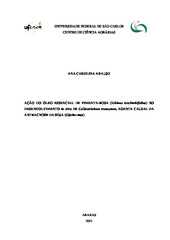Mostrar el registro sencillo del ítem
Ação do óleo essencial de pimenta-rosa ("Schinus terebinthifolius") no desenvolvimento in vitro de "Colletotrichum truncatum", agente causal da antracnose da soja ("Glycine max")
| dc.contributor.author | Araujo, Ana Carolina | |
| dc.date.accessioned | 2021-05-04T13:50:16Z | eng |
| dc.date.available | 2021-05-04T13:50:16Z | eng |
| dc.date.issued | 2021-04-09 | eng |
| dc.identifier.citation | ARAUJO, Ana Carolina. Ação do óleo essencial de pimenta-rosa ("Schinus terebinthifolius") no desenvolvimento in vitro de "Colletotrichum truncatum", agente causal da antracnose da soja ("Glycine max"). 2021. Trabalho de Conclusão de Curso (Graduação em Agroecologia) – Universidade Federal de São Carlos, Araras, 2021. Disponível em: https://repositorio.ufscar.br/handle/ufscar/14223. | * |
| dc.identifier.uri | https://repositorio.ufscar.br/handle/ufscar/14223 | |
| dc.description.abstract | the soybean is one of the most economically important crops in the world and has been cultivated by thousands of family farmers, especially in the southern region of the country. Crop productivity can be threatened by various types of pathogens that cause various diseases, including anthracnose, caused by the fungus Colletotrichum truncatum. One of its main control methods has been the application of fungicides in crops, which contributes to increasing environmental insecurity and concern for the health of the population. In this sense, the use of vegetable oils in phytopathogenic control can be an interesting alternative to replace such chemicals. The present study aimed to evaluate the effect of the essential oil of pink pepper (Schinus terebinthifolius) on the in vitro growth of colonies of the fungus Colletotrichum truncatum, the causal agent of anthracnose in soybean. The essential oil was applied in different ways to the Potato-Dextrose-Agar (BDA) culture medium in separate Petri dishes. Then, mycelial disks of the fungus were plated and their growth evaluated at 3, 5, 7 and 9 days. The results show that the greatest control of the growth of the pathogen occurs in T3 (essential oil on the surface), usually followed by T4 (filter paper). In addition, from 500 μl to 800 μl, approximately 1 centimeter of growth was suppressed on the 9th day. | por |
| dc.description.sponsorship | Não recebi financiamento | por |
| dc.language.iso | por | por |
| dc.publisher | Universidade Federal de São Carlos | por |
| dc.rights | Attribution-NonCommercial-NoDerivs 3.0 Brazil | * |
| dc.rights.uri | http://creativecommons.org/licenses/by-nc-nd/3.0/br/ | * |
| dc.subject | Manejo ecológico | por |
| dc.subject | Controle alternativo | por |
| dc.subject | Pimenta-rosa | por |
| dc.subject | Fungo fitopatogênico | por |
| dc.title | Ação do óleo essencial de pimenta-rosa ("Schinus terebinthifolius") no desenvolvimento in vitro de "Colletotrichum truncatum", agente causal da antracnose da soja ("Glycine max") | por |
| dc.title.alternative | Action of the essential oil of pink pepper (Schinus terebinthifolius) in development of Colletotrichum truncatum, causal agent of soybean anthracnosis (Glycine max) | eng |
| dc.type | TCC | por |
| dc.contributor.advisor1 | Mello, Ana Paula de Oliveira Amaral | |
| dc.contributor.advisor1Lattes | http://lattes.cnpq.br/0308248590715976 | por |
| dc.description.resumo | A soja é uma das culturas mais economicamente importantes no mundo todo e tem sido cultivada por milhares de produtores familiares, sobretudo na região Sul do país. A produtividade da cultura pode ser ameaçada por vários tipos de patógenos causadores de diversas doenças, entre as quais está a antracnose, causada pelo fungo Colletotrichum truncatum. Um de seus principais métodos de controle tem sido a aplicação de fungicidas nas lavouras, o que colabora para o aumento da insegurança ambiental e da preocupação com a saúde da população. Nesse sentido, a utilização de óleos vegetais no controle fitopatogênico pode ser uma alternativa interessante para substituir tais produtos químicos. O presente trabalho teve como objetivo avaliar o efeito do óleo essencial de pimenta-rosa (Schinus terebinthifolius) no crescimento in vitro de colônias do fungo Colletotrichum truncatum, agente causal da antracnose em soja. O óleo essencial foi aplicado de diferentes formas no meio de cultura Batata-Dextrose-Ágar (BDA) em placas de Petri separadas. Em seguida, discos de micélio do fungo foram plaqueados e o seu crescimento avaliado aos 3, 5, 7 e 9 dias. Os resultados mostram que o maior controle do crescimento do patógeno ocorre em T3 (óleo essencial sobre a superfície), seguido usualmente por T4 (papel filtro). Além disso, de 500 μl para 800 μl, houve a supressão de aproximadamente 1 centímetro de crescimento no 9º dia. | por |
| dc.publisher.initials | UFSCar | por |
| dc.subject.cnpq | CIENCIAS AGRARIAS::AGRONOMIA::FITOSSANIDADE | por |
| dc.publisher.address | Câmpus Araras | por |
| dc.contributor.authorlattes | http://lattes.cnpq.br/4077771101339527 | por |
| dc.publisher.course | Agroecologia - Ae-Ar | por |

